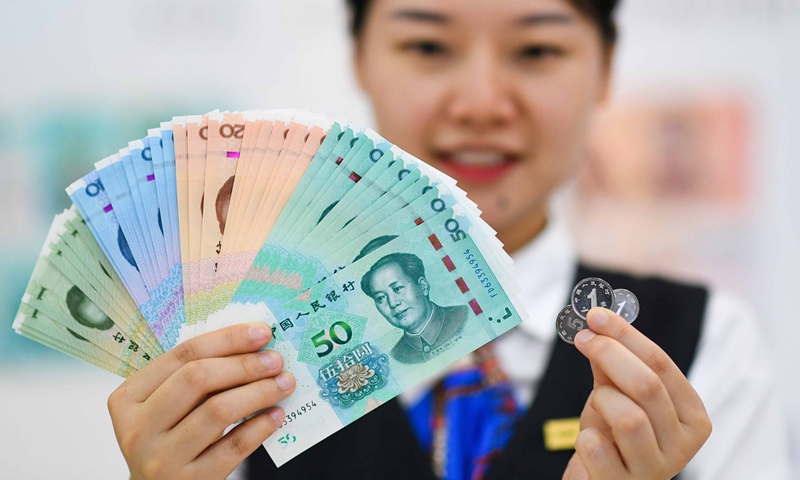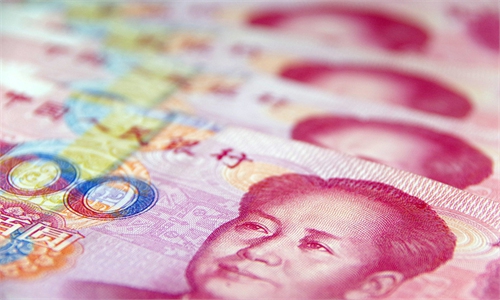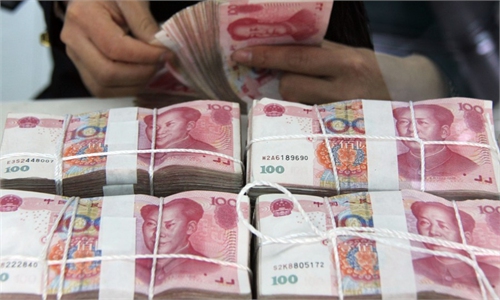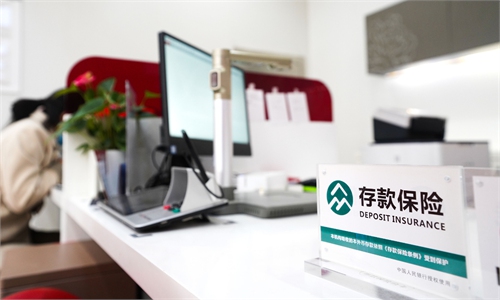Chinese banks to ramp up credit support for real economy amid challenging environment

A staff member displays the banknotes and coins included in the 2019 edition of the fifth series of the renminbi at an Industial and Commercial Bank of China (ICBC) branch in Beijing, capital of China, Aug 30, 2019.(Photo: Xinhua)
The assets and liabilities of China's top four state-owned banks grew rapidly and their profitability rose steadily last year despite the challenging economic environment. The hard-won achievement reflected the resilience of China's banking sector, which has gotten off to a strong start this year, experts said.
The net profits of Industrial and Commercial Bank of China increased 3.1 percent to 361 billion yuan ($52.4 billion), a record high, and it ranked No.1 among the four state-owned lenders.
China Construction Bank, with total assets of 34.6 trillion yuan at the end of 2022, reported a gain of 6.33 percent in net profits to 323.2 billion yuan.
Agricultural Bank of China said its profits rose 6.9 percent, while the profits of Bank of China rose 4.47 percent.
"The challenging economic environment marked by weak domestic demand and supply, increasing uncertainties in the external environment as well as multiple cuts in market interest rates weighed on the banking sector last year," Dong Ximiao, chief researcher at Merchants Union Consumer Finance Co, told the Global Times on Monday.
The People's Bank of China (PBC), the country's central bank, lowered the one-year loan prime rate (LPR) by 15 basis points (bps) in total, while the five-year LPR was slashed by 35 bps in 2022.
"Against this backdrop, the hard-won growth demonstrated the resilience of domestic banking sector," Dong said.
The big four lenders reported slower growth in their operating income last year.
China's financial authorities are encouraging banks to reduce borrowing costs for the real economy, while low effective credit demand has intensified market competition. Those factors combined to lead to relatively slow growth in the banks' operating income, Dong remarked.
During their earnings conference calls, officials of many listed banks vowed to increase credit for the real economy this year.
Zhang Xuguang, deputy head of Agricultural Bank of China, said that China's macroeconomic trend has been positive so far this year, with consumption and industrial output rebounding.
The bank will maintain steady growth in credit extension and bond investment this year, Zhang said.
Hao Cheng, deputy head of Bank of Communications, said that the bank will continue to promote optimization of the credit structure, and maintain its service to the real economy. The bank aims to expand yuan-denominated loans by about 12 percent this year.
Since 2023 began, banks have obviously strengthened their credit support for the real economy.
After a strong start in January, domestic banks issued a higher-than-expected amount of new yuan-denominated loans in February, totaling a record high of 1.81 trillion yuan. The figure was up 592.8 billion yuan year-on-year, data from the PBC showed.
The momentum gained in the first two months probably continued into March, experts said.
New yuan-denominated loans in March are estimated at 3.6 trillion yuan, which would be an increase of about 500 billion yuan year-on-year, according to Wang Qing, chief macroeconomic analyst at Golden Credit Rating International.
The ongoing economic recovery in March amid supportive policies including cuts in the reserve requirement ratio, taxes and fees will lead to a boom in credit supply and demand, Wang said.
With demand for personal mortgages and consumer credit showing a gradual recovery, some banks' first-quarter credit extensions exceeded the total for the first half of last year.
Banks will continue to provide credit to advanced manufacturing and strategic emerging industries, as well as consumer fields such as automobiles, green home appliances, and housing, all of which will help expand domestic demand, experts said.
The PBC said at its regular fourth-quarter monetary policy committee meeting in December that more efforts will be made to guide financial institutions to increase medium- and long-term loans to the manufacturing sector, and strive to make financial support for private firms commensurate with their contribution to economic and social development.
"As the real estate sector is expected to gradually achieve a soft landing around the middle of this year, banks' ratings for the sector will improve, and the growth rate of loan balances in the sector is likely to bottom out," Wang noted.




